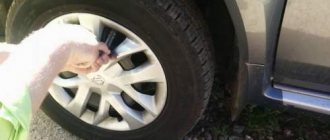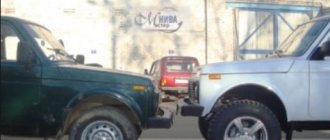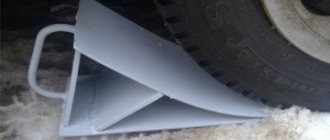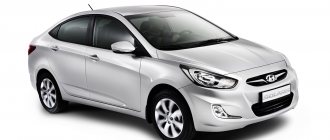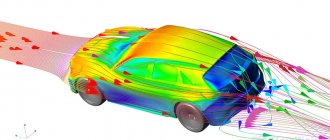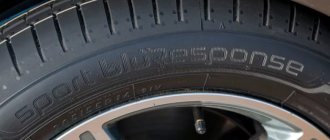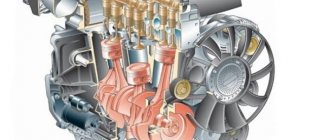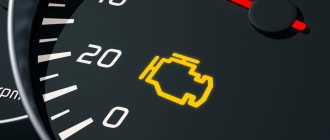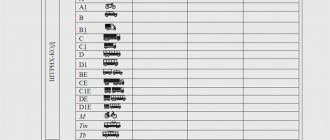To help buyers understand the wide range of tires for passenger cars and other vehicles, tire markings are used. Pictograms and inscriptions are printed on the sidewall of the wheel.
Correct decoding of their designations allows the car owner to select a suitable ramp that can ensure long-term and safe operation.
Country of Origin
Usually the largest inscription on the sidewall is the manufacturer's company brand. It allows you to distinguish the tire from its competitors.
Many companies have their own tire production plants in different countries. You can determine the place of production by the inscription “Made in...”. Please note that it may not be present on all slopes.
In this case, you will need to refer to the DOT code designation. The place of production will be encrypted in the form of two letters. The list below provides a breakdown of the main countries producing tires.
Model and tread type
Most manufacturers must indicate the model and modification of the tires. In some cases, information about the type of tread used is provided. Knowing the tire model, you can always determine whether it is suitable for certain operating conditions.
Speed index
Letters of the Latin alphabet encrypt the speed index. The table below will help you determine its value.
Speed index value
Table - Explanation of the speed index
Load
The load index determines the load-carrying capacity of the tires. It is indicated as a number before the speed indicator. The table below allows you to decipher the maximum load index.
Table - Maximum load
Definition of tire design
Based on their structure, tires are divided into radial and diagonal. The former are very popular and are designated by the Latin letter R. Diagonal tires are rare and are designated by the letter D.
Comparison of radial and bias tire design
Tire sizes
Tire size is indicated in three numbers. The landing diameter is indicated after the letter defining the design of the ramp. Its value is measured in inches. It must completely match the size of the wheel rims.
Other tire sizes are indicated using a division sign. The first number indicates the width of the tire. The second number shows the profile height as a percentage of the previous parameter.
Tire type
Most of the tires used are tubeless. They are marked Tubeless on the sidewall. Tube rubber is gradually losing ground, but is still used in some places. It is indicated by the inscription Tube Type.
Marking of tubeless and tube tires
Additional private labeling
Some manufacturers expand information about the tire with additional markings. This is how you can often find the wear resistance index. It appears after TREADWEAR. Its value ranges from 100 to 500. The higher the value, the longer the protector will wear off.
The temperature resistance of tires at high speed is indicated after the Temperature inscription. The value has three types: A, B and C. The best indicator is A, and the worst is C.
The highest permissible pressure in the wheel is indicated by the inscription MaxPressure. Its value is given nearby in kilopascals (kPa) or bars at the discretion of the manufacturer.
- The inscription Reinforced indicates that the rubber has been reinforced with another layer of cord or in some other way.
- The letter “F” or the inscription Frontwheel denotes tires that can only be mounted on the front axle. Likewise, tires labeled “Rear wheel” are placed only on the rear of the vehicle.
- In some cases, the material from which the ramp is made may be indicated. You can often find the inscription “2 POLYESTER CORD+2 STEEL CORD”. It means that the wheel has two layers of steel and polyester cord.
- The tread composition can be given separately, for example, Plies: tread and the composition of the Sidewall layer.
The ply rate is indicated by the letters PR. For passenger tires the markings 4PR and 6PR are usually used. Trucks, vans and buses use 8PR tires. With a directional tread pattern and on asymmetrical tires, the outer side is indicated by the inscription OUTSIDE or Side Facing Out. The inside is marked with the words INSIDE or Side Facing Inwards.
Some tires can only be installed on one side of the vehicle. Their markings include Left or Right. In the first case, the slope is left-sided, and in the second - right-sided.
For correct installation, the direction of rotation of the wheel can be indicated. It is denoted by the word Rotation.
The reinforced tire is designated by the letters XL, which stands for Extra Load. If it contains a metal cord, then the word Steel will definitely be present.
If there are manufacturing defects that do not affect the comfort and safety of driving, a DA or Secunda stamp is placed on the sidewall.
Tires with low rolling resistance reduce fuel consumption and the emission of harmful carbon dioxide into the atmosphere. They are designated Green X or Reduces CO2.
- If there is a non-directional tread pattern, the tire is marked with the letters ND or the phrase Non Directional.
- If tires are designed for low speeds, they will have NHS symbols on them, which stand for Non Highway Service.
All-terrain slopes are marked SAG or Super All Grip. Tires for crossovers are labeled SUV or Sport Utility VehiCles.
If there is a possibility of deepening the tread pattern, then the inscription REGROOVABLE is present on the sidewall.
A tire retreaded after use is indicated by the inscription RETREAD.
Tires that cannot be studded are labeled Studless, while tires that do have studs are labeled Studdable. A stingray with spikes will have the inscription Studded.
Tires from domestic manufacturers must have GOST or TU stamped on the sidewall.
American tire markings
American tires have slightly different tire size designations. For example, 30 x 9.5R 16 LT. You can see the transcript in the table below.
Table - Decoding of the American tire designation
SymbolDecoding
| 30 | External size |
| 9,5 | Tire width |
| R | Radial type |
| 16 | Inner diameter |
| LT | Commercial LightTruck |
Tire seasonality
On the sidewall there is a marking for all-season and winter tires. An example of the marking of a stingray, which can be used at any time of the year, is shown in the photo below.
In some cases, all-season tires may have a whole set of pictograms.
The MS badge is found on both all-season and winter tires. It means "mud + snow".
Compliance with ECE quality requirements
If the tire meets the standards of the Economic Commission for Europe, information about this is indicated on the tire along with the number. The table below will help you decipher it.
Table - Standard numbers
Spikes used
The table below provides a breakdown of information about spikes.
Table - Decoding information about spikes
Code symbolsDecryption
| SD | Carbide core |
| AD | Aluminum spike |
| O.D. | Oval core |
| M.D. | Plastic tenon with carbide core |
| DD | Diamond core |
Wear indicator and puncture protection information
- The presence of a wear indicator and its location are indicated using the inscriptions TWID, TWI, DSI.
- Manufacturers announce additional protection against punctures with various inscriptions.
- Table - Puncture protection
Additional color marks
- The yellow marking indicates the easiest place on the slope. Red reports the presence of force heterogeneity.
- A white stamp with a number indicates the inspector's number.
- Colored stripes were created for the convenience of warehouse workers.
Determining the year of manufacture of a tire
The ability to determine the year of manufacture of tires is extremely important for a car owner, since the shelf life of tires is limited to a period of 4-11 years. Its duration depends on the correct storage of the stingrays.
The production date is indicated in four digits. In an oval stamp on the sidewall of the tire. The first two digits indicate the week of manufacture, and the last two digits indicate the year.
There are special services on the network that simplify decryption.
The three-digit code indicates that the tire was manufactured before 2000. If there is a space between * and the number, then the tire is from the 90s. Otherwise the tires are from the 80s.
Tired of paying fines? There is an exit! Forget about fines from cameras! An absolutely legal new product - Traffic Police Camera Jammer, hides your license plates from the cameras that are installed in all cities. More details at the link.
- Absolutely legal (Article 12.2);
- Hides from photo and video recording;
- Suitable for all cars;
- Works through the cigarette lighter connector;
- Does not cause interference to radios and cell phones.
Source: https://kolesospec.ru/baza/markirovka-shin.html
Regulatory requirements and standards GOST 5513-97
A complete list of compliance with the requirements of truck tires is described in GOST 5513-97. The document regulates all standards regarding such tires and the required parameters. All markings must be on the outside. The height of 1.6 mm is the minimum for a tire tread. When these indicators are reached, the kit must be replaced. Winter tires have completely different standards - here the critical number is 2.5 mm of remaining tread height.
According to this document, the ply standard for tires is also regulated. Ply - the number of layers of cord on the sidewall of the rubber. For bias-ply truck tires, the designation starts with 8 plies, and the maximum value is 18. Radial wheels are more durable and modern.
Treadwear - tire wear resistance index / What is it?
Every consumer hopes to purchase a product that will last them a long time. This rule also applies to tires.
Over the past 10-15 years, wheel manufacturers began to apply a tire wear resistance index to their products so that the buyer could focus on the approximate service life of the tires.
We will share information: where the wear resistance symbol is located on the wheel and how it is deciphered.
What is tire wear resistance coefficient - how is it designated?
The founder of the development of the wear resistance index on wheels was the National Highway Traffic Safety Administration NHTSA. This organization represents part of the US Department of Transportation.
Your most vivid memories are wrong
Memories of exciting and dramatic events are called flashbulb memories in psychology, and they turn out to be full of errors.
Well-known examples of this phenomenon are the events surrounding 9/11. Psychologists asked participants to describe in detail what they did, where they were and other details immediately after the terrorist attack and 3 years later.
It turned out that 90% of later descriptions differed from the original ones. Many people can describe in detail where and what they were doing when they heard the news. The only problem is that these details are incorrect because strong emotions associated with the memory distort the memories.
Decoding car tire markings
It is quite easy to decipher the tire markings. At the same time, not many car enthusiasts can immediately understand such designations as the speed index, load index or tire design. It happens that of all the inscriptions on the wheel, only the name of the company is clear and does not raise questions. Therefore, we propose to work together to decipher these “ciphergrams” on tires.
In fact, the designations printed on the surface of car tires are not anything complicated and contain a set of technical parameters and other useful information. The marking indicates the tire size, its type, maximum permissible speed, maximum load, model, year of manufacture, and a number of additional data.
In addition, our website has detailed information about the marking of wheels for passenger cars and crossovers.
Marking of tires for passenger cars
The figure below shows the principle of tire marking with an explanation of the symbols on them, which is used by leading tire manufacturers.
The marking of car tires consists of a number of digital and letter designations, the decoding of which allows you to find out complete information about them:
- Manufacturer;
- Model and type of tread;
- Indices: speeds, loads, structures;
- Dimensions (width, profile height, rim diameter);
- Tire type;
- Additional markings (date of production, country of origin, marks of conformity, installation location, etc.).
Below we will look at each of these markings in detail.
Tire manufacturers
The first thing car enthusiasts usually pay attention to is the tire manufacturer. Among the most famous brands, products from the following companies stand out:
- Dunlop,
- Bridgestone
- Michelin,
- Pirelli
- Metzeller,
- Heidenau,
- Continental,
- IRC.
It is generally accepted that the more reputable the brand, the better the quality of the wheels. But, as practice shows, this is not always the case.
Less well-known brands in the car tire market are: Mitas, Cheng Shin, AvonShinco, Sava, Kenda, Duro, Maxxis.
Model and tread type
Tires must, first of all, meet the requirements set by the vehicle manufacturer. Therefore, in our opinion, you should start selecting tires by choosing a specific model and tread type.
Depending on the type of tread, tires can be:
- Sports and semi-sports;
- City and road;
- All-terrain and universal.
You can also find tires without a pattern (slick), which provide optimal grip on the most even and dry road surface, and rain tires - for confident driving on wet roads.
Further, experts recommend paying attention to such specific parameters as speed, load and tire design indices.
Speed index
The speed index conventionally indicates the maximum permissible wheel speed. The table below shows the breakdown of speed indices for car tires.
Table 1 – Tire speed indices
| Speed index | Speed (km/h) | Speed index | Speed (km/h) | Speed index | Speed (km/h) |
| L | 120 | R | 170 | V | 240 |
| M | 130 | S | 180 | W | 270 |
| N | 140 | T | 190 | Y | 300 |
| P | 150 | U | 200 | ZR | >240 |
| Q | 160 | H | 210 | ZR(Y) | >300 |
Speed index values are designated by letters from “A” (speed 40 km/h) to “Z” (speed over 300 km/h). True, the developers of the standard somewhat violated the alphabetical sequence by placing “H” (speed up to 210 km/h) between the letters “U” and “V”.
Load Index
The load index indicates the maximum permissible load on a tire at its maximum internal air pressure. The following table shows the breakdown of load indexes in tire markings.
Table 2 – Tire load indices
| Load Index | Max. load (kg) | Load Index | Max. load (kg) | Load Index | Max. load (kg) |
| 50 | 190 | 67 | 307 | 84 | 500 |
| 51 | 195 | 68 | 315 | 85 | 512 |
| 52 | 200 | 69 | 325 | 86 | 530 |
| 53 | 206 | 70 | 335 | 87 | 545 |
| 54 | 212 | 71 | 345 | 88 | 560 |
| 55 | 218 | 72 | 355 | 89 | 580 |
| 56 | 224 | 73 | 365 | 90 | 600 |
| 57 | 230 | 74 | 375 | 91 | 615 |
| 58 | 236 | 75 | 387 | 92 | 630 |
| 59 | 243 | 76 | 400 | 93 | 650 |
| 60 | 250 | 77 | 412 | 94 | 670 |
| 61 | 257 | 78 | 425 | 95 | 690 |
| 62 | 265 | 79 | 437 | 96 | 710 |
| 63 | 272 | 80 | 450 | 97 | 730 |
| 64 | 280 | 81 | 462 | 98 | 750 |
| 65 | 290 | 82 | 475 | 99 | 775 |
| 66 | 300 | 83 | 487 | 100 | 800 |
For passenger car tires, load indices are indicated by numbers from “50” (maximum load is 190 kg) to “100” (maximum load – 800 kg). In addition, there is a designation of the maximum load both in kilograms (KG) and in pounds (LBS) - “Max. Load 212KG" or "Max. Load 467LBS".
It’s probably not worth reminding that exceeding the permissible values can cause quite serious damage to the wheels. Therefore, choose tires with a small margin to avoid unusual situations on the road. Read more about how to do this correctly here.
Design Index
Using a design index, a tire manufacturer identifies certain design features:
- Radial tires are the most widespread. They are marked in the form of the letter “R”, which means the radial arrangement of the cords, as well as the non-equilibrium profile design. Radial tires have high load capacity and elasticity.
- Bias tires are marked with a “–” symbol. In them, the crossed threads of the cord and breaker are located at an angle of 30-40 degrees to the plane passing through the axis. These tires have a balanced design.
You suffer from “inattention blindness”
Watch the following video. You need to count the number of passes made by people wearing white T-shirts. Watch the video BEFORE continuing reading.
This is an example of what is called "inattentional blindness." The idea is that we are often blind to what is happening literally “under our noses” if we are focused on some other task.
In this case, a man in a gorilla suit walks through a group of players, stops and walks away. Participants busy counting passes often simply do not notice the gorilla. Moreover, those who know about the gorilla's appearance become even more inattentive and miss other changes - such as the change in the color of the curtains and the departure of one of the girls.
When will your tires wear out? Learning to count using Treadwear
When choosing a new set of summer or winter tires, you probably compare all the parameters of your future purchase: tire size, load and speed index, manufacturer, cost. Comparative tests from major automotive publications shed light on consumer qualities. But even they cannot predict how long a tire will last.
But it turns out there are numbers on the sidewalls of the tires
,
which
you
about the durability and wear resistance of rubber!
Let's figure out what this
Treadwear parameter
,
how to calculate mileage
, and why, unfortunately, it is not written on all tires.
Treadwear is usually indicated closer to the tire tread
Why have few people heard about Treadwear?
Indicate operational parameters on the sidewall
To undergo successful certification and bring the tire to the market,
tire manufacturers were forced to come to the USA.
The parameters
of the Uniform Tire Quality Grading (UTQG)
include the following data:
- Treadwear
- tire wear resistance - Traction
- tire grip on wet asphalt - Temperature
- resistance to tire overheating
If the tire is UTQG certified for the US market, then you will find 3 corresponding symbols on the sidewall.
The conclusion follows from this: if the tire is produced in Russia for the domestic market, then, alas, you will not find these designations.
How to calculate the life of a tire using the Treadwear index?
Treadwear characterizes the wear of a tire relative to a reference tire.
The test takes place on mostly rural desert public roads in the United States.
: four rear-wheel drive cars (one on test tires, others on standard tires) move along a given route of
7,200 miles
(or in the usual metric system 11,587 km) with regulated stops, checks and changing wheels along the axles.
At the end of the route, the tested tire is compared with the standard: if the wear is equal to the standard tire, an index of 100 is assigned, if it is half as much - 200
,
etc. It is believed that a mileage of 30,000 miles (or 48,280 km) is taken as 100.
I want to emphasize that this is a run in “greenhouse” test conditions
,
real mileage will be at least 2 times less
for good operating conditions with careful driving.
I would call this figure the " operating factor"
"(from 2 to 5), which everyone should choose for themselves depending on their driving style, typical routes, vehicle weight, road surface, etc.
Actual mileage = (48280 * Treadwear) / 100 / Operating coefficient
For example, for a tire with Continental Sportcontact Treadwear 280
, which means
the real mileage
can reach 48280 * 280/100/2 =
67592 km
And for
Michelin Energy Saver - 400
, which means
its mileage under the same conditions
can be
400/280 =
1.43 times
greater , i.e.
96.6 t.
km This tire will be quite wear-resistant - Treadwear 440
What else does the treadwear parameter say?
You already understand that Treadwear allows you to indirectly evaluate and compare tires.
, figure out which one will last longer.
This parameter also allows you to evaluate the hardness of the compound and its purpose.
:
- 600
- the car will fall into disrepair, but the tires will be like new
PS
Like it
???? , share the article, subscribe to the channel, comment - this will help me understand what should be discussed in more detail, what topics to cover, what is interesting to you, readers!
Source: https://zen.yandex.ru/media/id/5ba9dd10e43d4500aa643443/5cb3309756b8c500b7ad09ba
Extra options:
Extra Load (XL)
– reinforced model, the load index of such tires is 3 units higher in comparison with simple tires of the same size.
Reinforced (C)
– designation of high-strength tires, most often refers to light truck models.
All Season (AS), Тous terrain
– all-season tires.
Any weather (AW)
– all-weather tires. Often, instead of letter symbols, icons are used (snowflake, cloud, sun, etc.).
Mudd & Snow (M&S)
– tires specially designed for both winter and all-season use.
D.A.
(Stamp) – designation of tires with minor manufacturing defects that do not interfere with safe operation.
DOT
- Approved by the US Department of Transportation.
E
– approved by the Economic Commission for Europe.
Inside
– designation of asymmetric tires. When installed, the inscription Inside must be on the inside of the vehicle.
Outside
– designation of asymmetric tires. When installed, the word Outside must be on the outside of the vehicle.
Left
– tires with this marking should be installed only on the left side.
Right
– tires with this marking must be installed only on the right side.
Made in Germany
– designation of the country of origin.
Max Pressure
– maximum permissible tire pressure, in kPa.
PSI
– Pressure index from 20 to 85 (only for tires with the index “C”).
Aqua, Aquatred, Rain, Aquacontact, Water, or umbrella icon
– means that the tires are designed for rainy weather and effectively prevent the occurrence of aquaplaning.
Regroovable
– indicated if it is possible to deepen the tread pattern by cutting.
Retread
– retreaded tires.
Rotation
– directional tires, the direction of rotation is indicated by an arrow on the sidewall of the tire.
Steel
– means that the tires are equipped with a metal cord.
Temperature
– temperature conditions provided for a specific model, there are three categories: A, B and C.
Treadwear, TWI
– coefficient or wear resistance index, determined in relation to the “base tire”, for which it is equal to 100.
Traction
– the adhesion coefficient, like the temperature regime, is divided into 3 categories: A, B and C. Coefficient A has the greatest value.
Tread
– indicates that the tire consists of 5 layers: a layer of artificial silk + 2 layers of steel cord + 2 layers of nylon. Applicable in the USA.
Tubeless (TL)
– designation of tubeless tires. If this marking is missing, the tire can only be used with a tube.
Tube Type (TT)
– operation is possible only with a camera.
Twid
– projector wear indicator.
➤ Car tire markings - detailed explanation
The designation on the side of a passenger car tire is called a marking. It consists of several numbers, letters and graphic elements, the number of which sometimes reaches 12-15.
Country and manufacturing company
All manufacturers put their logo and name on the side of the wheel.
Many companies have factories in different countries, and the quality of their products can vary significantly. For example, Japanese Bridgestone tires can be produced in Italy, France, Finland, Thailand, Malaysia and many other countries.
Some tires have the inscription “Made in...”, but if it is not there, you can find out in which country the tires were produced by the DOT code. Thanks to it, you can also find out the series, plant and date of manufacture of a specific item.
The country of origin is encrypted in the form of 2 letters, which are located immediately after the abbreviation DOT. For example:
Each manufacturer has its own system for naming its factories. This is how the famous Bridgestone brand puts such codes on board
- 1D; EH; EJ; EK; EL; EM; EN; EP; H4 – country of origin: Japan;
- 0B; 0W; 1C; 2C; 2M; 3M; 4D; 5D; 7B; 8B; D2; HY; VA; VD; VE; W1; W2 – USA;
- 1U – China;
- 1V,A7 – Thailand;
- 3Y,7G, E2–Poland;
- 5T, 6T – Brazil;
- VN, 9B – Canada;
- A8 – Indonesia;
- J2 – Singapore;
- L5 – Türkiye;
- LH–Australia.
Model and tread type
In addition to the brand name, manufacturers indicate its model on the tire. Most brands have several model series (or lines), which differ:
- tread pattern and type;
- composition of the material used;
- purpose;
- seasonality.
Within one model, the buyer can choose the diameter and wheel profile that suits him.
Each line is designed for a specific user, for whom speed, durability or economy are important. For example, Michelin has in its range the Energy model, which is environmentally friendly and saves fuel.
For lovers of fast and hard driving, the Michelin Primacy model is designed, providing a high speed index and controllability during maneuvers.
The model name has numbers and letters. They are written immediately after the name of the manufacturer.
By the name of the model it is easy to determine the pattern and type of tread.


